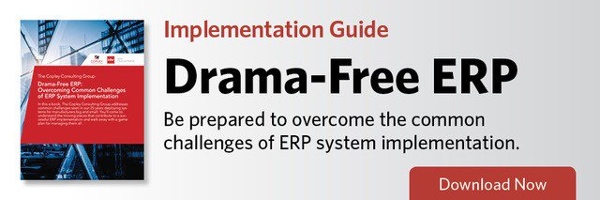In this special blog series, we’ll be discussing common challenges we’ve seen in our 25 years deploying ERP systems for manufacturers big and small. Over the next few weeks, you’ll come to understand the moving pieces that contribute to a successful implementation and walk away with a game plan for managing them all.
For those who have never gone through it, an ERP implementation might be viewed as a large-scale IT project. But those who’ve lived to tell the tale know that it’s much more than that: it’s a major change in how you do business.
Change will always be accompanied by some anxiety. Even if our current operating environment isn’t ideal, we know what limitations and challenges exist, and have devised work-arounds and process to address them. But when faced with a shift in those daily activities, however likely the potential for positive change, there will always be people who fear what’s to come. The ways in which this fear manifests during ERP rollout – namely in the form of resistance – can lead to delays, or even failure.
Here are three steps for proactively addressing fear before it can negatively impact your ERP deployment.
Bring Your Fears to The Table
However rational or irrational, there will be employees who are afraid of what lies on the other side of ERP implementation. They may fear losing control or power. They may be concerned they will no longer be able to perform their core functions or that those functions will change in unforeseen ways. They may worry that there are simply not enough hours in the day to get the job done.
Those who fear implementation may actively resist the process by remaining silent during problem-solving sessions or vocalizing negative attitudes at every opportunity. Others may simply not show up.
You can get ahead of this issue by inviting your team members to share their concerns. This can be accomplished through a transparent workshop approach during planning discussions, or through an anonymous questionnaire that allows space for employees to articulate their apprehension.
By acknowledging these feelings and bringing them out in the open, you can transform fear into a motivator rather than a threat – which brings us to our next step.
Unmask the Unknown
Once you have a handle on what the primary fears of your workforce are, you will be in a better position to assuage them. One way to approach this is to gather a core team representing all key company functions to discuss current procedures. Outline all the steps in the current process and give everyone an opportunity to share the perceived shortcomings, to voice what’s gone wrong and to speak out on what needs to change.
This will put your employees in a more receptive mindset when you discuss how the ERP solution aims to improve upon current processes. Your goal here is to convey that the project’s driving forces align with their own. You want to paint a picture of what life with your new ERP system will look like – and to talk through the issues they fear may arise in getting there. As for the deployment process, tell them who will be involved, how long it will take, how much it will cost, and how roles and expectations will change.
By eliminating the factor of the unknown, you can create an atmosphere where feelings of fear can be replaced with those of hope and excitement.
Draw Up Your Contingency Plan
Of course, as a business leader, you might have your own fears in being this transparent with your employees. If you share the hopes riding on your new ERP system, you run the risk of making promises you can’t keep.
That’s why a backup plan is so important.
Take a look through that list of fears from your employees to give yourself a reality check. Are people worried they won’t have enough time to do their jobs while dedicating attention to system rollout? Then, consider a pool of temporary employees who can help support their workload in a pinch.
Are folks downstream in the process worried about how deployment will affect customer deliverables? Then, think about adding some extra time to the acceptance testing phase to act as a buffer.
Remember: fear, however unsettling, serves a purpose. Hearing your employees’ concerns can be a good reminder of what needs to be accounted for to avoid your worst-case scenario. Rather than allowing fear to be an internal dialogue or a private conversation between cubicle walls, invite it into the room. Then, work together with your employees to ensure those fears don’t become a reality.

